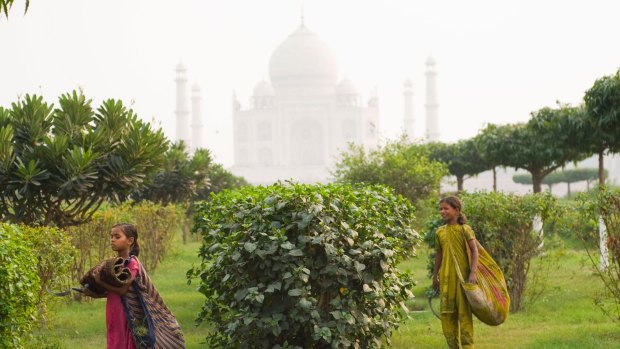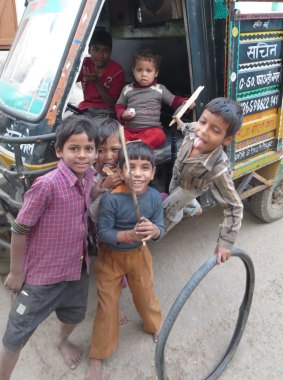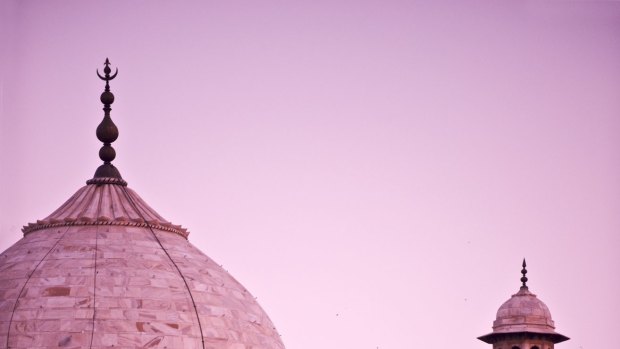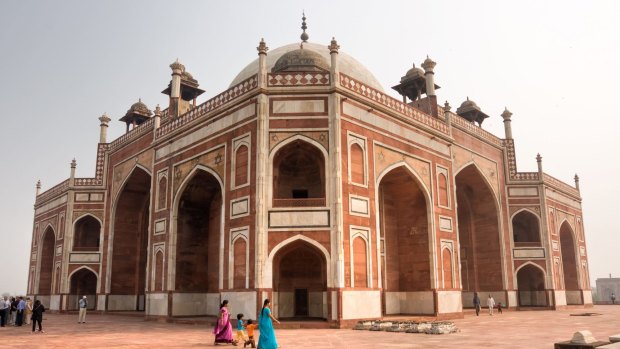This was published 8 years ago
Mughal walking tour, India: How to avoid the crowds at the Taj Mahal
A grassroots walking tour gives Rob McFarland a new perspective on the Taj Mahal.
By Rob McFarland

Girls work in the Mehtab Bagh (Moonlight Garden) in sight of the famous Taj Mahal palace.Credit: Alamy
"What's that?" I ask, pointing at the smoke curling up from the opposite riverbank. "Burning bodies," replies my guide nonchalantly. "They'll gather the ashes and scatter them in the Ganges."
Through the smoky haze I can see the world's most famous monument, a building Bengali poet Rabindranath Tagore described as "a teardrop on the cheek of eternity".
Apart from my guide and two ladies in colourful saris filling buckets from a nearby water pump, there is no one else around.

Local boys in Kacchpura, Agra.Credit: Rob McFarland
The reason we're not besieged by touts and other tourists is because we're on the north bank of Agra's Yamuna River, among farmland and villages, far away from the clamorous crowds. Yet, there, less than a kilometre away is the Taj Mahal.
This tour, known as the Mughal Heritage Walk, is a joint community-based tourism initiative by US government agency USAID, Agra local council and a non-profit agency called CURE (Center for Urban and Regional Excellence). It aims to help local people derive an income from tourism, and improve living standards and sanitation.
Until recently, most people in the area didn't have access to proper toilets and the bathroom was a communal piece of land 30 minutes' walk from the village.

The Taj Mahal as seen at dusk from the north bank of Yamuna River.Credit: Damien Simonis
Now, thanks to income from the tours, many houses have a toilet and the village has a new sewerage treatment plant. Other improvements include paved roads, upgraded drains and street lighting.
For tourists, the walk is an opportunity not only to admire the Taj Mahal from a different perspective, but also to see remnants of the area's Mughal history and to give something back to the local community.
After meeting Lekhraj, my smartly dressed 22-year-old local guide, we walk down a dusty road to the banks of the Yamuna River to see the last remaining element of an outdoor observatory built in the 16th century by the second Mughal emperor Humayun. Known as Gyarah Sidi, this two-metre-high set of graduated stone steps was used to compile astronomical tables.

The Humayun tomb in New Delhi.Credit: Alamy
Leaving the river, we stroll through fields of wheat, millet and watermelon to a simple brick settlement with a makeshift corrugated iron roof. It belongs to a local farmer and is typical of the basic living conditions in the region. Inside, there's an old-fashioned sewing machine and a small, dung-fuelled fire warming a tarnished metal pot.
Out in the yard the farmer's wife, dressed in a mauve sari, washes dishes. A water buffalo methodically chews nearby. The couple's nine-year-old son, still in school uniform, proudly shows off a handmade wooden bow and arrow.
We continue into Kacchpura, a village with 437 households and a population of around 3000. Lekhraj explains that half the village derives its income from farming; the other half from making shoes.
Wandering through the narrow, brick-paved streets, we soon attract a moat of curious children who gaze up in wide-eyed fascination.
We visit one of five women's groups the tours have helped to set up. Finding paid work as a woman in the area is difficult – women aren't allowed to leave the village and most lack any formal education. This group teaches girls how to make laundry bags, greeting cards and bookmarks. Along the way, they learn about finance, sales and marketing. The group started working from home but now rents a shared space that doubles up as an information centre. Other groups focus on women's health, beautician training, storytelling and theatre. The theatre group puts on shows for the community that emphasise the importance of sanitation and cleanliness.
Another remnant of early Mughal architecture in the village is Humayun Mosque, a five-arched brick building that was constructed when Humayun ascended to the throne in 1530.
Normally the tour ends in Mehtab Bagh (Moonlight Garden), a complex of manicured gardens on the banks of the Yumuna River opposite the Taj Mahal. However, we're running late so instead we retire to a rooftop to watch the sunset.
All around us are the sights and sounds of village life. A young girl chops herbs with a scythe on the bare concrete floor to make saag. Three chattering teenagers usher a bleating flock of goats along a dusty path. A lone boy flies a kite in a freshly ploughed field. It's a snapshot of rural India, a scene repeated in towns and villages all over the country. Except for one crucial difference. There on the horizon, luminous in the early evening dusk, is one of the most beguiling buildings on the planet.
FIVE MORE WAYS TO EXPERIENCE THE TAJ MAHAL
PRIVATE BALCONY DINNER AT OBEROI AMARVILAS
Enjoy a romantic candlelit dinner on the private balcony of your Oberoi suite with an uninterrupted view of the Taj Mahal. See www.oberoihotels.com.
TAJ MAHAL BY MOONLIGHT
Night tours of the Taj Mahal run five days each month - on the night of the full moon and the two nights either side. Numbers are limited and visits last 30 minutes. See www.banyantours.com.
LUNCH AT SKYDECK
Experience traditional Indian cuisine with a side order of Taj Mahal views at the Gateway Hotel's Skydeck rooftop restaurant. See www.thegatewayhotels.com.
SPA TREATMENT AT OBEROI AMARVILAS
What could be more soothing than a traditional Ayurvedic massage? One with a view of the Taj Mahal, of course. See www.oberoihotels.com.
SET YOUR ALARM
The early start will be painful but being one of the first into the Taj Mahal when it opens at sunrise means you can enjoy it in relative solitude. Watching the marble change colour in the early-morning sun is unforgettable.
TRIP NOTES
MORE INFORMATION
GETTING THERE
Air India flies direct from Sydney and Melbourne to Delhi, and then on to Agra. Phone 1800 247 463, see www.airindia.in.
STAYING THERE
Enjoying an unrivalled position just 600 metres from the Taj Mahal, the opulent Oberoi Amarvilas is consistently rated by TripAdvisor as the number one hotel in Agra, see www.oberoihotels.com.
SEE + DO
Banyan Tours can create a tailor-made Indian itinerary including accommodation, transfers, activities and domestic travel. The Mughal Heritage Walk costs $US41 per person; see www.banyantours.com.
The writer travelled as a guest of Air India, Banyan Tours and Oberoi Hotels.
Sign up for the Traveller Deals newsletter
Get exclusive travel deals delivered straight to your inbox. Sign up now.